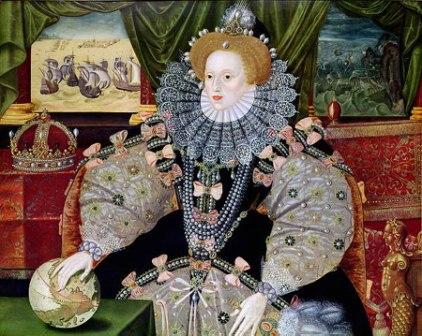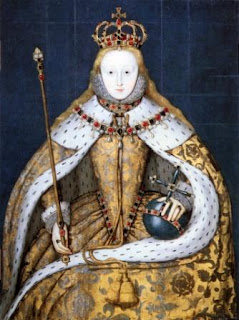 |
| The Hampden Portrait of Queen Elizabeth I, c. 1563. Attributed to Steven van der Meulen. Philip Mould Fine Paintings. Picture acquired through Wikimedia Commons. Image public domain. |
The Hampden Portrait of Queen Elizabeth I was painted c.1563 and is attributed to Steven van der M eulen. Its existence was first documented in the 19th century, when it was still part of the private collection at Hampden House, which also included a portrait of Queen Elizabeth that had been intended as a gift for Mary, Queen of Scots, and a portrait of Queen Mary I (Burke, 186). The portrait was originally given as a gift from Queen Elizabeth to Griffith Hampden to commemorate her visit to Hampden House; this was a typical way in which Queen Elizabeth demonstrated her gratitude to those who housed her and her extensive retinue on progress. The Hampden Portrait was sold at auction through Sotheby's in London on the 22nd of November, 2007. It was purchased by Philip Mould Fine Paintings of London for 2,596,000 pounds!
Through his studies of the portraits of Queen Elizabeth I, Sir Roy Strong has determined that The Hampden Portrait is one of the first portraits of Queen Elizabeth I to include a political agenda, since she had only just survived a brush with death due to smallpox, and needed to reassert her authority. In the portrait, Queen Elizabeth I wears a red and white dress; this was likely purposeful, chosen to signify the unity of the House of York and the House of Lancaster through the marriage of Henry VII and Elizabeth of York, which brought relative peace to England after years of dynastic struggle (a series of wars posthumously known as the Wars of the Roses) and established the illustrious Tudor dynasty. To further the message, the Queen wears a Tudor rose corsage and Tudor rose collar around her neck. The pendant worn by the Queen appears to be one of the Arundel gems, later acquired by the Duke of Marlborough in the 18th century. The tapestry in the background includes the Queen's heraldic arms and a tree bearing fruit, advertising Elizabeth's fertility.
Strong has identified The Hampden Portrait as the first portrait of Elizabeth I to include the armillary sphere as a royal emblem; the sphere can be seen on the lower part of her large strand of pearls. This celestial sphere was used ad naseum in the Renaissance and was adopted by Queen Elizabeth I. Other notable appearances of the armillary sphere include:
* at the end of a French psalter given to Elizabeth when she was Princess
* on the back of a coin from about 1569
* on the Queen's sleeve in a portrait from the 1580's
* and in The Ditchley Portrait the Queen's earring is shaped like an armillary sphere
Queen Elizabeth has removed her left glove in order to display her "beautiful hand", as it was described by Giovanni Michiel in 1557 when he wrote to the Venetian Doge. In her right hand, the Queen holds a pink carnation, also known as a gilly-flower. The gilly-flower represents betrothal, and tantalizingly hints at an impending marriage, which of course never came to fruition.
The realm of England had descended into chaos for a brief time when Queen Elizabeth I contracted smallpox and nearly died in 1563. Upon recovering, there was even more pressure on the Queen to marry; in the event of illness or death, her Councillors wanted her to have an heir to carry on the Tudor line and to preserve the kingdom.
Criticism of Queen Elizabeth's apprehension to marry was at a fever pitch. Alexander Nowell, the Dean of St. Paul's, critically addressed the Queen's unmarried state at the opening of Parliament in January of 1563, saying, "All the Queen’s most noble ancestors have commonly had some issue to succeed them, but Her Majesty none … the want of your marriage and issue is like to prove a great plague." Rather contemptuously he concluded, "If you parents had been of your mind, where had you been then?" Nowell was expressing the opinions held by many, and Queen Elizabeth knew that she had to respond to relieve her people of their fears.
 |
| Queen Elizabeth I presiding over Parliament, circa 1580-1600. Picture acquired through Wikimedia Commons. Image public domain. |
Queen Elizabeth I addressed Parliament on the issue of her marriage and succession on 10th April, 1563. She also addressed the House of Lords, saying, in part,
"…the two proceedings that you presented me, in many words
expressed, contained these two things: my sortie in marriage, and of your cares
the greatest, my succession, of which two the last I think is best be touched,
and of the other a silent thought may serve, for I had thought it had been so
desired as none other tree's blossoms should have been minded or hope of my
fruit had been denied you. If any here doubt that I am, as it were, by vow or determination
bent never to trade that life (i.e., marriage), put out that heresy; your
belief is awry. I hope I shall die in quiet
with nunc dimittis; which can not be without I see some climpse (glimpse) of
your following surety after my graved bones (i.e., death)."
Sotheby's has presented a possible connection between The Hampden Portrait and a portrait of Robert Dudley, the Earl of Leicester from c. 1564 which was formally at Apethorpe but is now in a private collection. Leicester is shown facing toward the right, and like the Queen is shown holding a glove in his hand. This hints at a link between the two portraits, especially when we consider that both of the gloves appear to be hawking gloves, and the two friends often hunted and hawked together, and also because Queen Elizabeth I and the Earl of Leicester had companion portraits painted on numerous occassions.
 |
| A portrait of Robert Dudley, the Earl of Leicester, c.1564. Picture acquired through Wikimedia Commons. Image public domain. |
Other portraits of Queen Elizabeth I from this time include the portraits mentioned within our article about The Clopton Portrait, as well as the following:
 |
| The sitter in the The Gripsholm Portrait, painted circa 1563, is generally believed to be Queen Elizabeth I. Picture acquired through Wikimedia Commons. Image public domain. |
The Gripsholm Portrait shows Queen Elizabeth I wearing clothing in the Italian style.
 |
| Elizabeth I and the Three Goddesses, 1569. Attributed to Hans Eworth and Joris Hoefnagel. Picture acquired through Wikimedia Commons. Image public domain. |
The allegorical Elizabeth I and the Three Goddesses was painted in 1569. It is attributed to both Hans Eworth and Joris Hoefnagel and is part of The Royal Collection.
 |
| A detail of the Queen from Elizabeth I and the Three Goddesses, 1569. Attributed to Hans Eworth and Joris Hoefnagel. Picture acquired through Wikimedia Commons. Image public domain. |
Sources:
J.B. Burke. A Visitation of the Seats and Arms of the
Nobleman and Gentleman of Great Britain.
Vol. I.1852.
R. Strong. Portraits of Queen
Elizabeth. 1963.
R. Strong. Tudor and Jacobean Portraits. 1969.
"Historical Portraits Picture Archive: Portrait of Elizabeth I (1533-1603)." Philip Mould Fine
Paintings. GalleryinaBox. Web. 15 May 2013.
"Sotheby's Catalogue Notes and Provenance: Portrait of Queen Elizabeth I (1533-1603)." Sotheby's
Important British Paintings. E-catalogue. Web. 15 May 2013.










